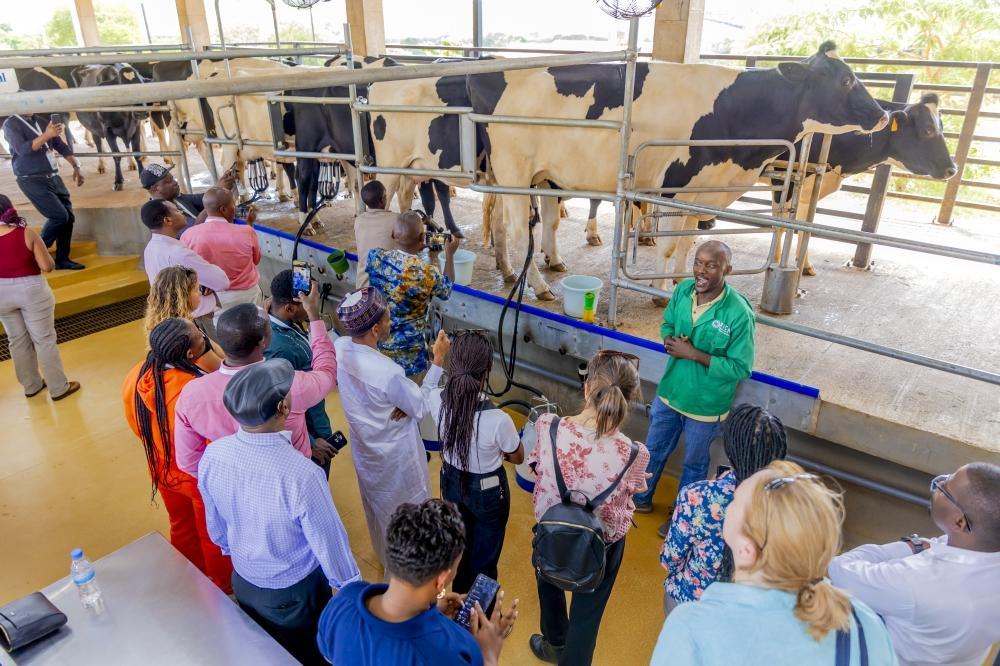Africa-Press – Rwanda. Agriculture is the cornerstone of Rwanda’s economy, engaging over 70 per cent of the population and contributing a significant portion of the nation’s GDP.
Farming in Rwanda is rapidly evolving, embracing innovation and modern techniques that are transforming the way food is grown and livelihoods are sustained.
While agriculture in Rwanda has long been rooted in traditional practices, today’s farmers are increasingly adopting efficient, high-yield methods that maximise productivity even on small plots of land. This shift is not only improving food security but also opening new economic opportunities for rural and urban populations alike.
Digital platforms and social media have become powerful tools in this transformation, with agriculture influencers and experts sharing practical advice, success stories, and cutting-edge farming techniques.
From hydroponics to climate-smart practices, these voices are inspiring a new generation of farmers to rethink old norms and adopt sustainable, productive approaches that align with Rwanda’s vision for a modern, resilient agricultural sector.
Delegates toured the Rwanda Institute for Conservation Agriculture (RICA) campus in June 2025, where they observed modern farm drainage technologies designed to improve water management and boost agricultural productivity. CourtesyRICA
The country’s varied climate and topography have led to diverse farming methods that range from deeply traditional to highly innovative.
Understanding these farming types provides insight into Rwanda’s food security, economic growth, and environmental sustainability.
Subsistence farming as a foundation of rural livelihoods
For the majority of Rwandans, farming remains a vital source of sustenance and survival. Subsistence farming continues to be widespread, especially among smallholder farmers in rural areas who cultivate modest plots primarily to feed their households.
Traditionally centred on mixed cropping of staples such as beans, maize, cassava, sweet potatoes, and bananas, alongside rearing livestock like goats, chickens, and pigs, subsistence farming forms the backbone of rural life.
However, subsistence farming in Rwanda is no longer static or purely traditional. Increasingly, local farmers are adopting improved seed varieties, better livestock breeds, and more efficient cultivation practices to boost productivity and resilience.
The integration of crops and animals continues to enhance soil fertility naturally, while government programmes and NGOs actively support these farmers with extension services, access to fertilisers, microcredit, and cooperative models to overcome challenges like land fragmentation and limited mechanisation.
This evolving approach ensures that subsistence farming remains a culturally significant and dynamic pillar underpinning Rwanda’s agricultural transformation.
How crop farming is powering food security and exports
Crop farming in Rwanda falls into two broad categories: food crops grown for local consumption and cash crops cultivated for sale, both domestically and internationally.
Staple foods such as beans, maize, cassava, sweet potatoes, and plantains dominate Rwanda’s agricultural landscape. These crops are adapted to different altitudes and soils and form the backbone of the Rwandan diet.
The government’s Crop Intensification Programme has promoted improved seed varieties, fertiliser use, and terracing to boost production and reduce food insecurity.
On the commercial side, coffee and tea are Rwanda’s flagship cash crops. These crops not only contribute significantly to export revenues but also provide income for smallholder farmers, who constitute 70 per cent of the population involved in agriculture in Rwanda.
Rwanda’s coffee, particularly the Arabica variety grown in volcanic soils, enjoys a premium reputation globally for its quality and distinct flavour.
Similarly, tea plantations in the highlands produce specialty teas that fetch good prices on international markets.
Other emerging commercial crops include pyrethrum, a natural insecticide, and horticultural products that command niche markets. Efforts to diversify crops and improve value chains are ongoing, with focus on processing, certification, and branding to maximise returns.
Livestock farming enhancing nutrition and economic stability
Animal husbandry complements crop farming by providing protein sources, manure for fertilisation, and alternative income streams. Rwandan farmers rear various animals including cattle, goats, sheep, pigs, and poultry.
Cattle, especially indigenous breeds, are prized for their milk and meat, but productivity is often limited by traditional rearing practices, diseases, and poor nutrition.
The government and partners are promoting improved breeds, veterinary services, and modern feeding techniques to increase milk yields and meat quality.
Goats and sheep offer fast turnover and adaptability to small-scale farms, while pig farming is growing, supported by rising urban demand for pork.
Poultry farming, both indigenous and improved breeds, provides eggs and meat, with many households keeping chickens for easy income.
Livestock farming faces challenges such as pasture scarcity, inadequate veterinary infrastructure, and the risk of zoonotic diseases.
However, it remains integral to rural resilience and livelihoods, and innovations like zero-grazing units and integrated crop-livestock systems are gaining traction.
Aquaculture as a growing source of protein and income
Fish farming is an increasingly important part of Rwanda’s agricultural landscape, particularly in regions with lakes, dams, and suitable water bodies. Aquaculture helps reduce pressure on wild fish stocks and addresses protein deficiencies.
The most commonly farmed fish species are tilapia and catfish. Tilapia thrives in Rwanda’s freshwater ecosystems, while catfish offers rapid growth and disease resistance. Smallholder fish farmers typically operate pond systems, which are being supported through training in pond construction, feeding regimes, and disease control.
Fish farming contributes to food security, provides direct income to farmers, and supports local markets and processing industries. The government’s emphasis on aquaculture is part of a broader strategy to diversify rural livelihoods and improve nutrition.
Horticulture increasingly becoming a cash cow
Horticulture in Rwanda encompasses the cultivation of fruits, vegetables, and flowers. This sector has witnessed significant growth due to increasing local demand, urbanisation, and export opportunities.
Common fruits include passion fruit, avocado, pineapples, and papaya, while vegetables such as French beans, carrots, tomatoes, and chili peppers are widely grown. The government supports horticulture through initiatives like export hubs, farmer cooperatives, and access to inputs and irrigation.
Rwanda’s strategic location and compliance with export standards have allowed it to tap into regional markets and international buyers, especially in Europe. The flower industry is also emerging, focusing on cut flowers for export.
Horticulture’s high value per unit area makes it attractive to smallholder and commercial farmers alike. Challenges include post-harvest losses, pest management, and climate variability, but technology and infrastructure improvements are addressing these issues.
Integrating agroforestry to boost sustainability and productivity
Agroforestry combines tree growing with crops or livestock on the same land, offering ecological and economic benefits. In Rwanda, where soil erosion and land degradation are pressing concerns, agroforestry is a key practice for sustainable farming.
Farmers plant trees such as Grevillea, eucalyptus, and fruit trees on their farms to provide shade, windbreaks, fodder, and firewood. Tree roots stabilise soil, reduce erosion, and enhance water retention. Additionally, fruit trees contribute extra income and improve diets.
This practice is particularly relevant in Rwanda’s hilly terrain, where terracing alone is insufficient to protect fragile soils. Agroforestry also promotes biodiversity, carbon sequestration, and climate resilience. The government and NGOs actively promote agroforestry through training, seedlings distribution, and integration into land-use policies.
Scaling up commercial agriculture to fuel economic transformation
While smallholder farming dominates, Rwanda is witnessing growth in commercial agriculture, driven by investment, improved infrastructure, and policy incentives.
Large-scale farms focus on key commodities like rice, tea, coffee, and flowers. Mechanised farming, irrigation, and improved seed varieties characterise this segment, which aims to meet domestic demand, boost exports, and create jobs.
Commercial agriculture also attracts private sector participation and foreign investment, linking Rwanda to global value chains. Challenges include land access, infrastructure gaps, and skills shortages, but government initiatives like Special Economic Zones and agribusiness incubators support this growth.
The expansion of commercial farming complements smallholder efforts and helps modernise Rwanda’s agriculture.
Organic and climate-smart farming to balance productivity with environmental health
Increasingly, Rwandan farmers are adopting organic and climate-smart agricultural practices to enhance sustainability and resilience.
Organic farming emphasises the use of natural fertilizers like compost and manure, crop rotation, and biological pest control. This approach improves soil fertility and reduces chemical residues, aligning with global demand for organic products.
Climate-smart agriculture integrates techniques such as terracing, drought-resistant crop varieties, agroforestry, and water harvesting. These methods help farmers adapt to changing weather patterns, reduce greenhouse gas emissions, and maintain productivity under stress.
Government policies and international partnerships promote climate-smart agriculture through extension services, farmer training, and pilot projects. This shift is essential for safeguarding Rwanda’s natural resources while feeding its growing population.
Hydroponics and innovation for urban and intensive farming
Hydroponics represents one of Rwanda’s most promising modern farming techniques, particularly in urban and peri-urban areas where land and water are scarce.
This soil-less cultivation method grows plants directly in nutrient-rich water solutions, allowing for precise control of growth conditions. Common hydroponic crops include leafy greens, herbs, lettuce, and strawberries.
Hydroponics offers several advantages: it requires significantly less water than traditional farming, eliminates soil-borne diseases, and enables year-round production. The method is ideal for greenhouses and indoor farms, providing fresh, pesticide-free produce to city markets.
Urban entrepreneurs and some agricultural cooperatives are adopting hydroponics to increase yields and profitability. With Rwanda’s push for agricultural innovation, hydroponics is expected to expand, contributing to food security and economic diversification.
That said, Rwanda’s agriculture is a mix of traditional practices and modern innovations. Rwanda is harnessing its natural resources and human capital to build a sustainable and prosperous agricultural sector.
Experts argue that continued investment in technology, infrastructure, and farmer capacity will be critical to overcoming challenges and ensuring that Rwanda’s farming landscape remains productive, resilient, and competitive on regional and global stages.
For More News And Analysis About Rwanda Follow Africa-Press






